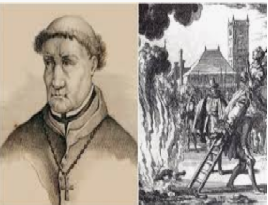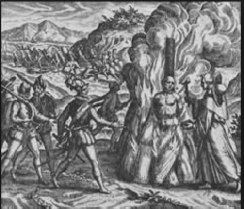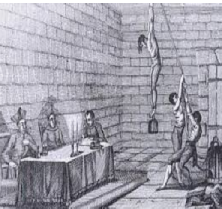|
PART 1 T O P I C |
|
|
|
|
|
|
|
|
|
|
|
|
|
|
|
|
|
|
|
CLICK BUTTON |
|
|
|
|
|
|
|
|
|
|
|
|
|
THE INQUISITION AND THE |
|
|
|
|
JewishWikipedia.info
FROM THE PROLOGUE TO
‘THE KIDNAPPING OF EDGARDO MORTARO’’
by David Kertzer, Knopf 1997
In 1858. In Rome, Pope Pius IX sat on St. Peter’s throne as French troops patrolled the Eternal City. Two of the three most powerful men in Bologna were cardinals: the Archbishop, the city’s spiritual leader, and the Cardinal Legate, representing the papal government, the civil ruler. The third was a military man, an Austrian general, whose troops (along with the French forces in Rome) ensured that the tottering Papal government did not fall.
Across the street from the general’s headquarters was the Dominican church of San Domenico where the Inquisitor lived. He was charged by the Congregation of the Holy Office in Rome with combating heresy and defending the faith. Among his tasks was ensuring that restrictions imposed on the Jews were obeyed.
For two centuries, Bologna’s inquisitors had had little reason to worry about the Jews, for in 1593 the Pope had expelled all nine hundred of them from the city and its surrounding territories. In the wake of the French occupation of the 1790’s a few adventurous Jews returned. Once the Papal States were restored, their status again became tenuous and their right to live in the city less than clear. Yet, by 1858 close to two hundred lived m Bologna, merchants for the most part, carving out a comfortable niche for their families. Given the Church authorities’ mixed feelings about their presence m the formerly forbidden city, the Jews had no desire to call attention to themselves, and so had neither synagogue nor rabbi.
In 1858 police, acting on the orders of the Inquisitor, went to the home of a Jewish merchant, Momolo Mortara, to arrest their six year old son. They sent him to a special monastery in Rome where Jews were converted into good Catholics. His parents learned that the family's Catholic servant, thinking he might die had claimed to have secretly baptized him as she feared that otherwise he would go to hell. Edgardo recovered, but the story had reached the Bologna Inquisitor, Their justification was that no Christian child could be raised by Jewish parents. It became an international cause célèbre. Refusing to return the child to his family, Pope Pius IX began to regard the boy as his own child. When eighteen he decided to become a priest. He died in a Belgian abbey in 1940 aged eighty eight.
His fate came to symbolize the entire revolutionary campaign of Mazzini and Garibaldi to end the dominance of the Catholic Church and establish a modern, secular Italian state. Had this not happened it is possible that the Pope would have become the first President of Italy and Catholicism more dominant.
MORTARA AFFAIR
World History 21-06-2015
On June 23, 1858, police in Bologna, Italy, descended on the home of Momolo Mortara and Marianna Padovani and their seven children. Sent on orders of the local inquisitor, they had come to seize the Jewish couple’s six-year-old son, Edgardo. The inquisitor, having determined that the boy had been secretly baptized, received instructions from the Holy Office of the Inquisition in Rome—headed by Pope Pius IX himself—to have the child taken. The church had long held that no baptized child of a Jewish family could remain with his parents, for they would exercise a pernicious influence on him. Whether the parents had authorized the baptism or even known about it was irrelevant from the church’s perspective. Although the Mortaras were not then informed of who allegedly had baptized their son, they later learned that a former domestic servant, Anna Morisi, claimed to have secretly baptized Edgardo when, at age twelve months, he was ill. Whether she actually performed such a baptism in the Mortara’s house remains a mystery, for she had other motives that might have led her to make such a charge.
Many similar cases of forced baptism followed by abduction by the police occurred in Italy in the first decades of the nineteenth century. What made the Mortara affair different was the international uproar that ensued. With separation of church and state being one of the main rallying cries of the Italian movement for national unification and with the primary obstacle being the continuing existence of the Papal States—of which Bologna was the largest city after Rome— the Mortara case offered champions of unification a golden opportunity to rally support. Moreover, Jews in western Europe were increasingly free to organize politically and to express their views through the expanding press. After the Damascus ritual murder case of 1840, the Mortara affair was the first major campaign of self-defense over which the international Jewish community organized. Indeed, the case led directly to the founding of the Alliance Israelite Universelle, the most important Jewish international self-defense organization in Europe.
Edgardo Mortara was taken directly from his house to Rome, where he was initially placed in the House of the Catechumens, established in the sixteenth century as a place to convert Jews and Muslims. But as the international protests grew— reaching as high as the French emperor and involving popular demonstrations in the United States, with 3,000 participants in San Francisco and 2,000 in New York—the pope himself began to play an active role. Indeed, Edgardo came to be treated as Pius IX’s adopted son, and the pope withstood all the pressure, arguing that it was his sacred duty to prevent the child from returning to his Jewish family. Not even his redoubtable secretary of state, Cardinal Antonelli, who argued that holding on to the child would be a political disaster for the precarious position of the Holy See, could move him. Attempts by the Jewish community of Rome to petition the pope on the Mortaras’ behalf were rejected.
A year after the Jewish boy was taken, the forces of Italian unification drove the cardinal legate out of Bologna and ended the pope’s temporal dominion there, as in much of the Papal States. In January 1860, police of the new regime arrested Father Feletti, Bologna’s inquisitor, at his Dominican monastery and charged him with the kidnapping of Edgardo Mortara. A few months later, the court acquitted him of the charge, ruling that he had acted according to the laws then in force. Edgardo had, by this time, been transferred to a Roman religious school run by the Canons Regular order at the Church of San Pietro in Vincoli, placed there by the pope himself. He was periodically shown off to visitors by Pius, who was eager to demonstrate that the boy was happy to have been plucked from his Jewish family and pleased to have found the true path to salvation.
Meanwhile, Momolo Mortara—a merchant of modest means—toured Europe to drum up support for the return of his son. With the Holy See now confined to the city of Rome and the surrounding area, the pope’s position became tenuous. Momolo sought to take advantage of the pope’s desperate need for all the diplomatic support he could get from France, Britain, and other countries. However, none of the efforts to apply pressure proved successful.
When Italian forces finally conquered Rome in 1870, destroying the last vestiges of the Papal States, Momolo Mortara hurried in to reclaim his son. Edgardo, however, now nineteen and not having seen his parents in a dozen years, had decided to become a priest. With the help of the monks of his monastery, he fled Rome just as his father was about to see him and then escaped Italy altogether. He did, indeed, become a priest, devoting much of his career to preaching throughout Europe in the several languages in which he was fluent, telling the inspirational story of how God plucked him from his Jewish family in order that he might attain true salvation.
The Mortara case not only had great significance for Jews but also played a role in the drama of Italian unification. The pope’s refusal to heed the pleas of Napoleon III helped further undermine his support for the continued existence of the Papal States, which French troops were then helping to maintain. More generally, the refusal to return Edgardo contributed to the growing sense that the pope’s role as temporal ruler, with his own police force, was an anachronism that could no longer be maintained.
Edgardo Mortara died in 1940 at age eighty-eight, in a Belgian abbey where he had lived for many years. He had reestablished contact with his mother in the 1870s—his father having died in the meantime—and in later years occasionally visited members of his family, whom he sought, unsuccessfully, to convert.
THE
INCREDIBLE
STORY OF THE JEWISH PEOPLE



KIDNAPPING OF EDGARDO MORTARA
Henry Abramson 2013 (5.28)
n the summer of 1858, 6-year old Edgardo Mortara, a Jewish boy living in Bologna, Italy, was forcibly taken from his home by Italian police acting at the behest of the Inquisition. It had come to the attention of the Church that a teenage non-Jewish servant girl had performed an "emergency baptism" on Edgardo several years earlier, fearing that he would die of a childhood illness and not be allowed entry into Heaven. Despite strenuous efforts by Jewish communities around the world, Pope Pius IX refused to release Edgardo, who ultimately became a priest in the Augustinian order and devoted his life to converting Jews to Catholicism
EDGARDO de MORTARO,
THE LAST INQUISITION ARREST
ABDUCTED:
THE KIDNAPPING OF EDGARDO MORTARA
BY POPE PIUS IX
Zionireland 2017 (38.41)
In a recent talk titled, Abducted, delivered at the Irish Jewish Museum, Yanky Fachler narrated the story of Edgardo Mortara to a cpativated audience.
Edgardo was a 6 year old Jewish boy living with his family in Bologna in the 1850s. Afflicted with a serious illness and close to death, he was "baptised" by a servant girl to ensure he entered (christian) Heaven. Jewish Edgardo recovered from the illness, but the servant's action set off a chain of events that dramatically altered the child's life. Claimed by the Vatican, Edgardo was forcibly removed from his family and taken to live in the Vatican, under the direct tutelage of Pope Pius IX. The ensuing furore pitted the Papacy against
nascent forces of democracy and Italian unification.
